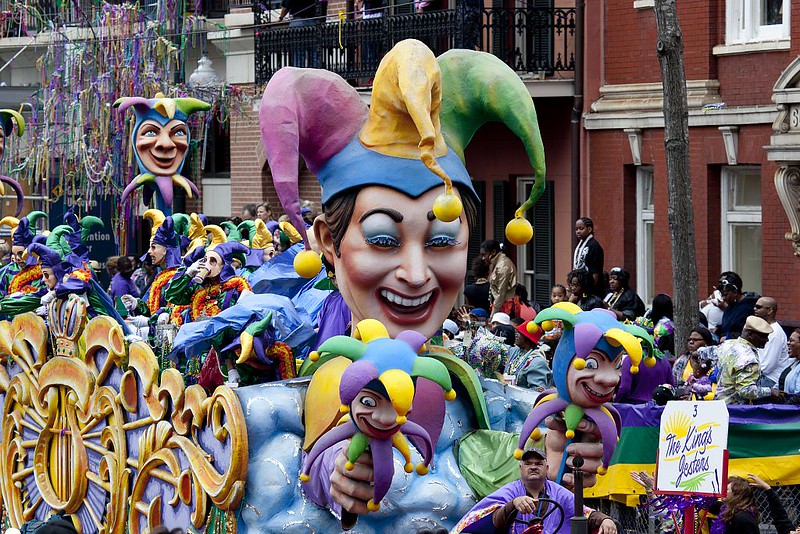Mardi Gras, often referred to as the “Greatest Free Show on Earth,” is a vibrant and culturally rich celebration that takes center stage in New Orleans. As the city comes alive with colorful parades, lively music, and a contagious spirit of revelry, locals and visitors alike eagerly anticipate the festivities. In this ultimate guide, we will delve into the history, traditions, and essential aspects of Mardi Gras in New Orleans, ensuring you’re well-equipped to make the most of this iconic celebration.
Table of Contents
Introduction
Mardi Gras, French for “Fat Tuesday,” marks the culmination of Carnival season and is celebrated with grandeur and enthusiasm in New Orleans. The city’s unique blend of history, culture, and festive spirit makes it the perfect host for this extravagant event. From its humble beginnings to the extravagant spectacles of today, Mardi Gras has become synonymous with New Orleans, drawing millions of visitors each year.
History of Mardi Gras in New Orleans
Origins and Early Celebrations
The roots of Mardi Gras in New Orleans can be traced back to the late 17th century when French explorers, led by Pierre Le Moyne d’Iberville, set foot on the Mississippi River. The French brought with them the tradition of celebrating Mardi Gras, or “Fat Tuesday,” the day before the Christian season of Lent began.
The initial Mardi Gras celebrations in the region were modest, reflecting the intimate gatherings of French settlers. Masked balls and processions were held, providing a sense of revelry and escapism before the solemn period of Lent.
Evolution of Mardi Gras Traditions
As New Orleans grew and diversified, so did the Mardi Gras celebrations. The infusion of African, Spanish, and Creole influences added a unique flavor to the festivities. By the early 19th century, Mardi Gras had become a more elaborate and public event.
The first documented Mardi Gras parade in New Orleans took place in 1837 when a group of revelers marched through the streets. This marked the beginning of the spectacular parades that are now synonymous with Mardi Gras in the city. The introduction of themed floats, intricate costumes, and lively music elevated the celebration to new heights.
Challenges and Resilience
The celebration of Mardi Gras faced various challenges throughout its history. The Civil War, Reconstruction, and economic hardships temporarily disrupted the festivities. However, the resilient spirit of the people of New Orleans prevailed, and Mardi Gras emerged stronger than ever.
The formation of secret societies or “krewes” became a prominent feature during the late 19th and early 20th centuries. These krewes organized and funded the elaborate parades, ensuring that Mardi Gras continued to be a grand spectacle for locals and visitors alike.
Modern Era Celebrations
In the modern era, Mardi Gras in New Orleans has reached unparalleled levels of extravagance. The city attracts millions of visitors annually who come to experience the vibrant parades, elaborate costumes, and the pulsating energy that permeates the streets.
Each year, different krewes contribute to the festivities with their unique themes and floats. The celebration has expanded beyond Bourbon Street, with various neighborhoods hosting their own events and parades, showcasing the diverse cultural tapestry of New Orleans.
Mardi Gras has become more than a single day of revelry; it’s a season that captures the essence of the city’s spirit. The rich history and traditions of Mardi Gras in New Orleans continue to shape this unparalleled celebration, making it a must-experience event for those seeking a taste of the city’s cultural heritage and festive exuberance.
Key Elements of Mardi Gras
Parades and Floats
Central to the Mardi Gras experience are the elaborate parades that wind their way through the streets of New Orleans. These processions feature intricately designed floats, each telling a unique story or carrying a specific theme. The parades are a visual feast, with colorful decorations, lively music, and enthusiastic participants tossing throws, including beads and trinkets, to the cheering crowds.
Costumes and Masks
One cannot speak of Mardi Gras without envisioning the elaborate costumes and masks that add a touch of mystery and fantasy to the celebration. Revelers go all out, donning extravagant outfits, masks, and accessories. The tradition of wearing costumes dates back to the early days of Mardi Gras, adding an element of theatricality and anonymity to the festivities.
Traditional Mardi Gras Foods
Mardi Gras is not just a visual spectacle; it’s a feast for the senses, and the culinary offerings play a crucial role. Traditional Mardi Gras foods are a delightful blend of flavors and cultures. From the iconic King Cake, a sweet and colorful pastry adorned with purple, green, and gold icing, to savory dishes like gumbo and jambalaya, the food is an integral part of the celebration.
Music and Performances
The rhythm of Mardi Gras is set by the lively music that fills the air. Brass bands, jazz ensembles, and lively street performers contribute to the festive atmosphere. Traditional Mardi Gras music, including tunes like “When the Saints Go Marching In,” creates a soundtrack that adds to the jubilant spirit of the celebration.
Throws and Trinkets
A distinctive aspect of Mardi Gras is the tradition of “throws” – items tossed from floats to the spectators. Colorful beads, doubloons (customized coins), and various trinkets become coveted treasures during the parades. The joy of catching these throws adds an interactive and playful element to the celebration.
King Cake Tradition
The King Cake holds a special place in Mardi Gras traditions. Baked in a circular shape and decorated in the traditional Mardi Gras colors, the cake conceals a small plastic baby. The person who discovers the baby in their slice is said to have good luck and is often designated as the host of the next gathering.
These key elements, woven together, create the tapestry of Mardi Gras in New Orleans. The celebration is a sensory extravaganza, engaging sight, sound, taste, and touch, making it a truly immersive and festive experience for all who participate.
Popular Mardi Gras Parade Routes
Mardi Gras parades are known for their vibrant and lively atmosphere, with colorful floats, lively music, and enthusiastic crowds. While specific parade routes may vary from year to year, some of the most popular and iconic Mardi Gras parade routes are in New Orleans, Louisiana. Here are a few notable ones:
- St. Charles Avenue: This is one of the main parade routes in New Orleans and is known for hosting several major parades, including the Krewe of Rex and the Krewe of Zulu. The route runs through the Uptown and Garden District areas.
- Canal Street: Canal Street is another significant parade route, and it serves as the dividing line between the Uptown and Downtown parade routes. It’s a bustling thoroughfare where parades like the Krewe of Endymion roll.
- Bourbon Street: While Bourbon Street is more famous for its lively nightlife, it also hosts some smaller Mardi Gras parades and walking krewes, creating a unique and festive atmosphere in the French Quarter.
- Frenchmen Street: This street is known for its eclectic music scene, and during Mardi Gras, it becomes a lively spot for parades and celebrations. It’s a popular choice for those looking for a slightly different Mardi Gras experience.
- Metairie Parade Route: Just outside of New Orleans, the suburb of Metairie hosts several family-friendly parades along Veterans Memorial Boulevard. The Krewe of Caesar and the Krewe of Endymion are among those that roll in this area.
Keep in mind that Mardi Gras parade routes may be subject to change, and it’s advisable to check with local authorities or Mardi Gras organizations for the most up-to-date information if you plan to attend.
Mardi Gras and Tourism
Mardi Gras, a vibrant and festive celebration, holds significant cultural and economic importance, particularly in regions like New Orleans, Louisiana. The event attracts a massive influx of tourists, contributing substantially to the local economy.
Mardi Gras, French for “Fat Tuesday,” marks the culmination of the Carnival season, featuring parades, masquerade balls, and lively street celebrations. The extravagant floats, colorful costumes, and lively music create an unparalleled atmosphere that draws people from all over the world.
Tourism plays a pivotal role in the success of Mardi Gras. The event has become a major tourist magnet, boosting the hospitality, entertainment, and retail sectors. Hotels, restaurants, and bars experience a surge in business during the festivities, as visitors seek accommodations and revel in the unique Mardi Gras experience.
Local businesses capitalize on the increased foot traffic, offering Mardi Gras-themed merchandise and services. Street vendors, souvenir shops, and food vendors thrive as tourists immerse themselves in the festive spirit, purchasing memorabilia and indulging in local cuisine.
Moreover, the economic impact extends beyond immediate revenue generation. Mardi Gras has become a significant marketing tool for the region, attracting media coverage and generating publicity. The cultural richness and distinctive celebrations contribute to the city’s overall appeal, encouraging repeat visits and fostering a positive image that resonates with potential tourists.
Despite the economic benefits, the surge in tourism during Mardi Gras also poses challenges. Managing the large crowds, ensuring public safety, and preserving the cultural essence of the celebration require careful planning and coordination. Local authorities work diligently to strike a balance between catering to the influx of visitors and maintaining the integrity of Mardi Gras traditions.
In conclusion, Mardi Gras and tourism share a symbiotic relationship, with the celebration serving as a major driver for the local tourism industry. The economic impact is substantial, benefiting various sectors and contributing to the overall vitality of the region. As Mardi Gras continues to attract a global audience, its role in promoting tourism and cultural exchange remains a key aspect of this lively and cherished tradition.
Conclusion
In conclusion, the Mardi Gras celebrations in New Orleans are a unique and unforgettable experience that captivates the hearts of all who partake in the festivities. From the rich history to the lively parades, the city comes alive with a spirit of joy and camaraderie during this annual celebration. Whether you’re a first-time visitor or a seasoned reveler, Mardi Gras in New Orleans promises an adventure like no other.
Frequently Asked Questions (FAQs)
- How can I secure a good viewing spot for Mardi Gras parades?
- Are Mardi Gras celebrations suitable for families with children?
- What are some must-try Mardi Gras foods in New Orleans?
- Are there any eco-friendly initiatives during Mardi Gras celebrations?
- Where can I purchase unique Mardi Gras souvenirs in New Orleans?





